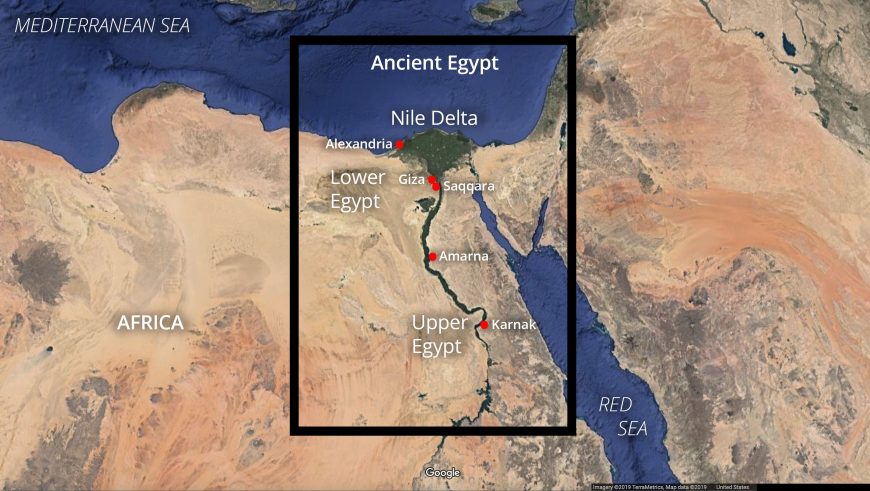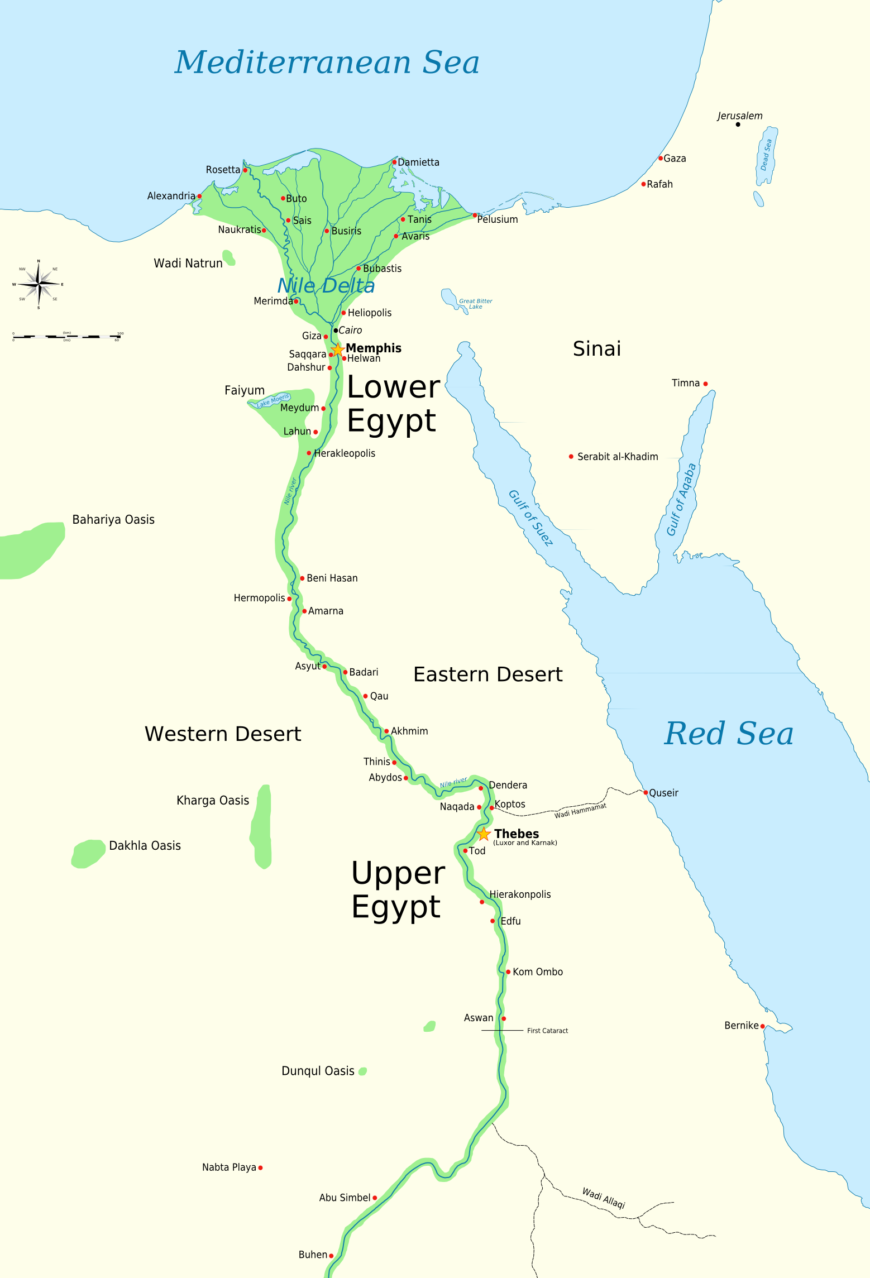Standing at the cusp of one of the longest-lived and most influential cultures that ever existed, the people living in the Nile valley during the fifth and fourth millennia B.C.E. laid the foundation for everything to come. During this era, powerful townships developed unique local cult practices and ruling organizations. The Two Lands (Upper and Lower Egypt) became united around 3000 B.C.E. under a single king, Narmer (or Menes), who ruled as the first king of Upper and Lower Egypt. Already in this early period, many of the distinct characteristics of Egyptian culture, including kingship ideology, writing system, social structure, religious beliefs, and modes of artistic representation were introduced and codified.
Predynastic Period (c. 5000–3000 B.C.E.)
This period saw the rise of several powerful towns, especially Abydos, Naqada, and Nekhen (commonly called Hierakonpolis) and a possible unified southern kingdom. Hieroglyphic writing emerged, probably for administrative and ritual purposes to support the rulers of these southern towns. The earliest known texts were short labels and captions, but the writing system developed rapidly and helped frame the dynamic civilization that emerged along the Nile.
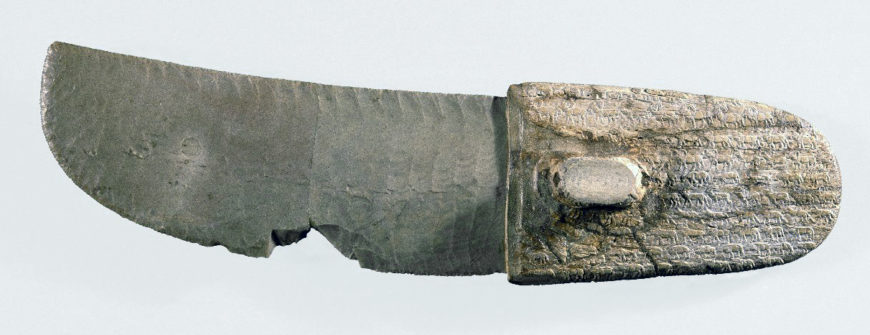
The ivory handle includes a thumb rest for a right-handed user. Carved rows of minuscule animals—including elephants, lions, a giraffe, and sheep—cover both surfaces of the handle. Ritual knife, c. 3300–3100 B.C.E., Pre-dynastic period, flint, elephant ivory, excavated Abu Zaidan, Egypt (Brooklyn Museum)
Copper tools and fine flint blades demonstrate the technological level of the period. Some of these flint blades sport handles with imagery that is decidedly Near Eastern in origin; these and other indications like the existence of objects crafted of lapis lazuli (a deep blue stone from Afghanistan) point to active trade between Egypt and western Asia at this time.
The craft of sculpture exploded with large-scale figures carved in stone, such as those excavated at Koptos. By the end of this era, burials sometimes included small coffins of basketwork or clay.
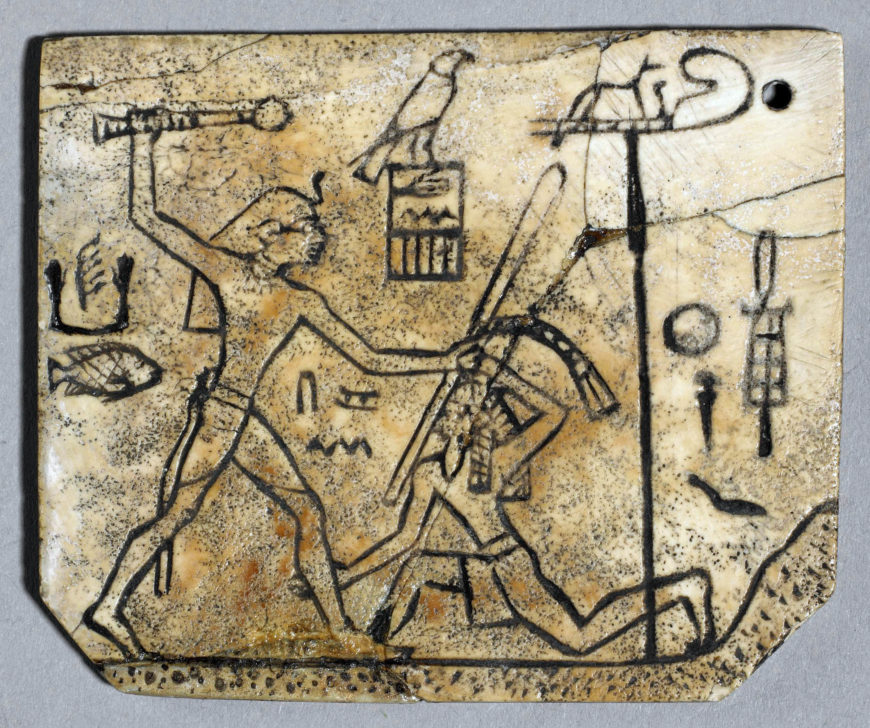
King Den’s sandal label, 1st dynasty, ivory, found at Abydos, Upper Egypt, 4.5 x 5.3 cm (© Trustees of the British Museum)
Early Dynastic Period (c. 3000–2686 B.C.E.)
The unification of north and south under a single ruler occurred c. 3000 B.C.E. Over the next couple of centuries, disparate townships and local cultures were bound together under the control of the single king, and a dynamic stratified society evolved. The second king to rule the newly unified Egypt introduced the important ritualized census called the “Followers of Horus.” In this annual or bi-annual event, the king and his court would tour the different regions of the country, called nomes, taking count of assets like cattle, grain, and goods. These counts would then be used to determine taxation required from each region, with proceeds being gathered to central storehouses for later distribution. These regular visits reinforced the king’s power throughout the country.
A complex pantheon of deities was already evident at this time. Local worship of Ra, Horus, Ptah, and Seth and many cult shrines were first established in this era. Items excavated from royal tombs included small labels, originally attached to grave goods, with scenes showing the king performing ritual actions for a variety of deities and may record actual visits to divine shrines associated with local cults. On the ivory label of king Den above, the ruler is shown smiting his restrained enemy before a cult object at the far right. The king’s name is clearly written in front of his face, surrounded by a falcon-surmounted rectangular form known as a serekh. He wears a prototype royal headdress with an upright cobra (called a uraeus) at his brow. The opposite side of this label is inscribed with a pair of sandals, indicating the type of grave item that it was originally attached to.
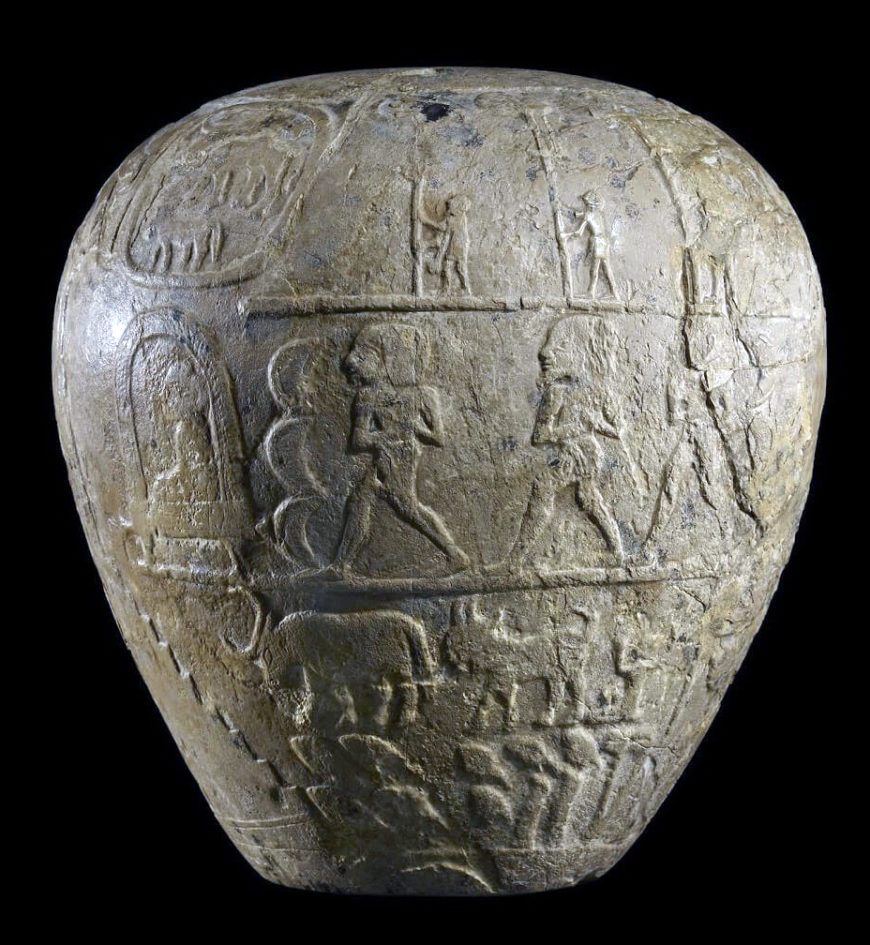
Narmer Macehead, Early Dynastic Period, c. 31st century B.C.E., found in Hierakonopolis (Ashmolean Museum, Oxford)
Other artifacts from this period include massive ceremonial mace heads, palettes, and stelae carved with scenes that commemorate important events.
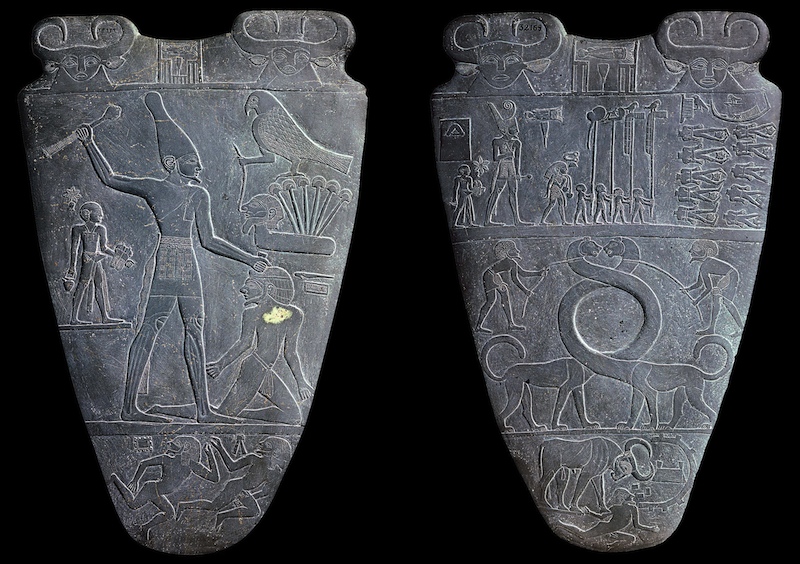
Palette of King Narmer, c. 3000–2920 B.C.E., Predynastic Egypt, greywacke (slate), from Hierakonpolis, 2′ 1″ high (Egyptian Museum, Cairo)
A number of these votive objects, such as the Narmer palette, were discovered together in a cache excavated in the temple precinct at Hierakonpolis. There seems to be an intentional blending of actual, historical events and ritual elements in the decoration of these objects, an early indication of the tendency in ancient Egypt to blur the lines between the physical and spiritual worlds.
The goddesses Nekhbet and Wadjet (referred to as the Two Ladies), representing Upper and Lower Egypt respectively begin to appear prominently on ritual objects, as do both the White Crown of the south and the Red Crown of the north—all symbols of the Two Lands that would be used for millennia to come.
Many artistic conventions were established during this period, as was much of the royal iconography that expressed the ideology of kingship. This includes specific poses, items of clothing and regalia, and image associations, such as the smiting pose, the wearing of various crowns, and the use of bull imagery as an analogy for the king, all of which are visible on the Narmer Palette.
With the First Dynasty, focus turned from south to north and the city of Memphis was selected as the capital of the united Egypt. This move also shifted the royal cemeteries from Abydos north to the site of Saqqara. Towards the end of this era, there is a change in focus from the king honoring the gods in their local shrines to a system where the deities came together to sanctify the king and aid his journey in the afterlife.
| Period | Dates |
| Predynastic | c. 5000–3000 B.C.E. |
| Early Dynastic | c. 3000–2686 B.C.E. |
| Old Kingdom (the ‘pyramid age’) | c. 2686–2150 B.C.E. |
| First Intermediate Period | c. 2150–2030 B.C.E. |
| Middle Kingdom | c. 2030–1640 B.C.E. |
| Second Intermediate Period
(Northern Delta region ruled by Asiatics) |
c. 1640–1540 B.C.E. |
| New Kingdom | c. 1550–1070 B.C.E. |
| Third Intermediate Period | c. 1070–713 B.C.E. |
| Late Period
(a series of rulers from foreign dynasties, including Nubian, Libyan, and Persian rulers) |
c. 713–332 B.C.E. |
| Ptolemaic Period
(ruled by Greco-Romans) |
c. 332–30 B.C.E. |
| Roman Period | c. 30 B.C.E.–395 C.E. |

